OneDrive - Guide for employees with Windows computer
Activate OneDrive
- Click on the Windows icon (in the bottom left-hand corner) to open the start menu.
- Search for ' OneDrive ' (be careful that you DO NOT select 'OneDrive for Business').
- When you are asked to log in, use your AU user name au<auid>@uni. au.dk and your password, and then approve the two-step authentication.
Clean up your files
- You are encouraged to clean up your files on the U drive, your desktop and the ‘Dokumenter’ (Documents) and ‘Billeder’ (Images) folders, and delete files that you no longer use. The less data you have, the faster your files will be moved to OneDrive.
- Not all files can be moved directly to OneDrive. This may be because the file name contains an invalid character. In these cases, the file name will automatically be changed during the transfer. Files larger than 250GB cannot be moved either. Your local IT support team will help you with this.
- Characters and files that are invalid on a Microsoft website:
'Invalid file names and file types on OneDrive and SharePoint' - Read more about automatic renaming of files with invalid characters on a Microsoft website:
'OneDrive can rename files with invalid characters'
- Characters and files that are invalid on a Microsoft website:
If you are working from home on the day your files are to be moved
Check when AU IT are going to start moving your files from the U drive to OneDrive in the email you received about the transition to OneDrive.
Please note that unfortunately you cannot use your computer while your files are being transferred to OneDrive. It is difficult to say exactly how much time the migration will take, but for approx. 80% of employees it will take approx. 10 minutes. However, if you have large amounts of data, it may take up to several hours.
How to initiate migration of your files to OneDrive
You have to initiate the migration yourself of your files from your desktop, 'Documents' and 'Pictures' folders to Onedrive. After the migration, you will still be able to access the files on your desktop and in the 'Documents' and 'Pictures' folders.
Follow steps 1-5 if you have activated OneDrive
Follow step 6 if you have not activated OneDrive
1. Start by logging in to AU’s VPN solution.
2. Once you have been logged in to the VPN for at least 90 minutes, you will have to log out of your computer and log in again. When you log in again, you will receive a pop-up message with the heading Redirection of local folders to OneDrive. Follow the instructions in the pop-up message, and in the subsequent messages listed below.
3.
4.
5. At the last box, it is important, that you check that you have selected ALL your folders before you proceed with the configuration. When you click on the Close the window button, the migration will begin.
6. If you have not been logged in to OneDrive before the day of the migration of your files, you will receive this pop-up message:
7.
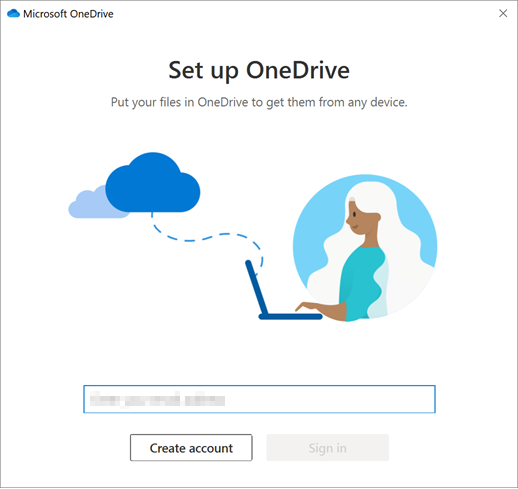
-
Once you have logged in, you will see a brief intro to OneDrive. Your computer may require restarting in connection with log in. If this happens, you will receive the following pop-up message.
8.
-
Once you have logged in to OneDrive, just follow steps 1 to 5.
Important information
- You will only have read access to the U drive when the file-migration process starts. Once the files have been moved to OneDrive, you will no longer be able to access them on the U drive. If you need to edit a file on the U drive during the move, you can save the file on OneDrive and work on it there. The move can take one to seven days, depending on the number and size of the files.
- When your files have been moved to OneDrive, you will no longer have access to the U drive.
- You will not receive a notification on your computer when the files have been transferred.
- You will still be able to access your files on your desktop and the 'Documents' and 'Pictures' folders.
If you are physically present at AU on the day your files are to be moved
Check when AU IT are going to start moving your files from the U drive to OneDrive in the email you received about the transition to OneDrive.
Please note that unfortunately you cannot use your computer while your files are being transferred to OneDrive. It is difficult to say exactly how much time the migration will take, but for approx. 80% of employees it will take approx. 10 minutes. However, if you have large amounts of data, it may take up to several hours.
How to initiate migration of your files to OneDrive
You have to initiate the migration yourself of your files from your desktop and the 'Documents' and 'Pictures' folders to Onedrive. After the migration, you will still be able to access the files on your desktop and in the 'Documents' and 'Pictures' folders.
Follow steps 1-4 if you have activated OneDrive
Follow step 5 if you have not activated OneDrive
1. When you log in to your AU computer, you will receive a pop-up message with the heading Redirection of local folders to OneDrive. Follow the instructions in the pop-up message, and in the subsequent messages listed below.
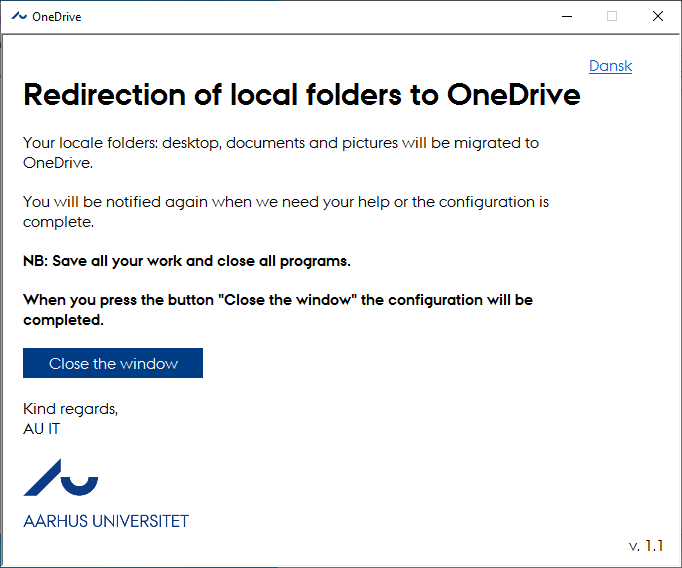
2.
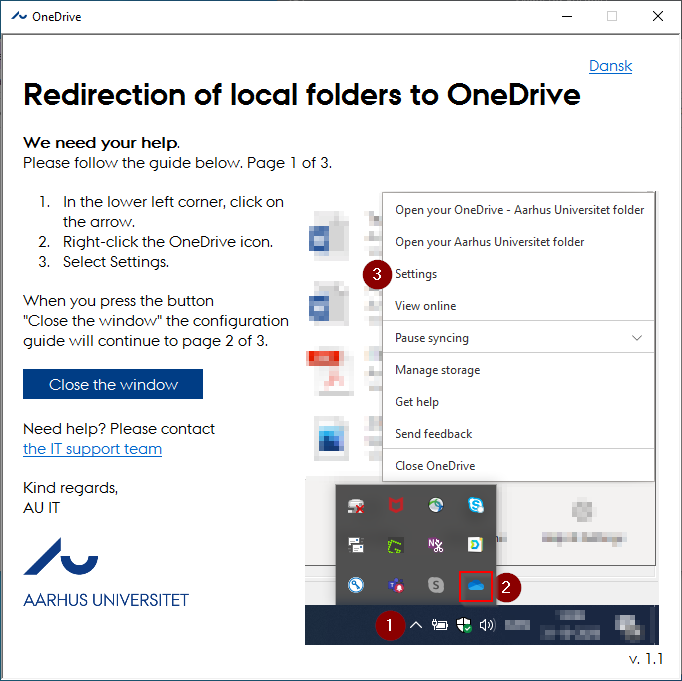
3.
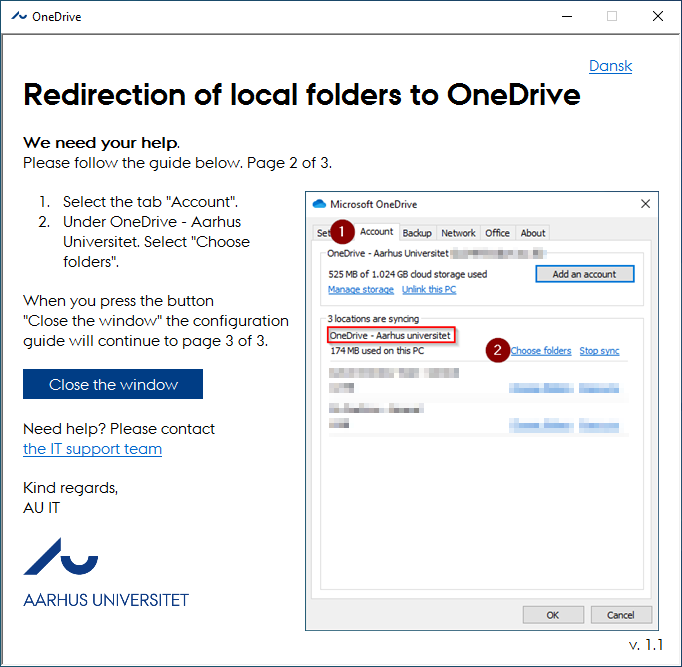
4. At the last box, it is important, that you check that you have selected ALL your folders before you proceed with the configuration. When you click on the Close the window button, the migration will begin.
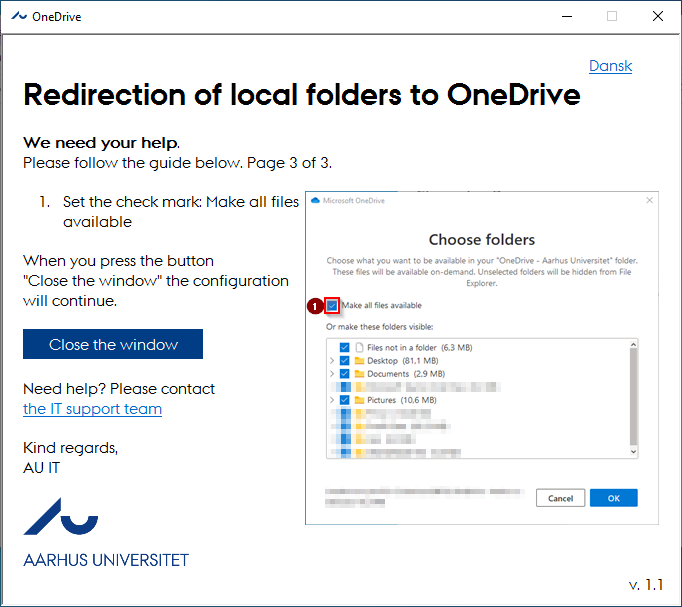
5. If you have not been logged in to OneDrive before the day of the migration of your files, you will receive this pop-up message:
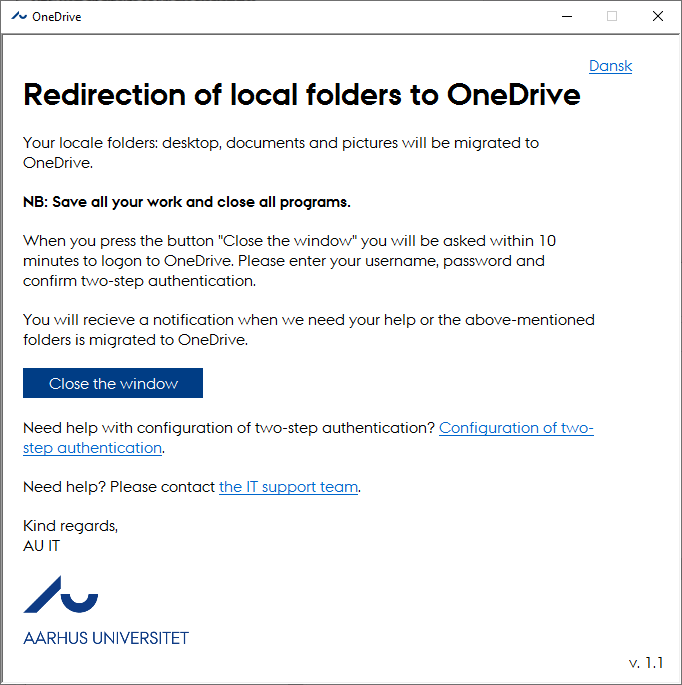
6.

7. Once you have logged in, you will see a brief intro to OneDrive. Your computer may require restarting in connection with log in. If this happens, you will receive the following pop-up message.
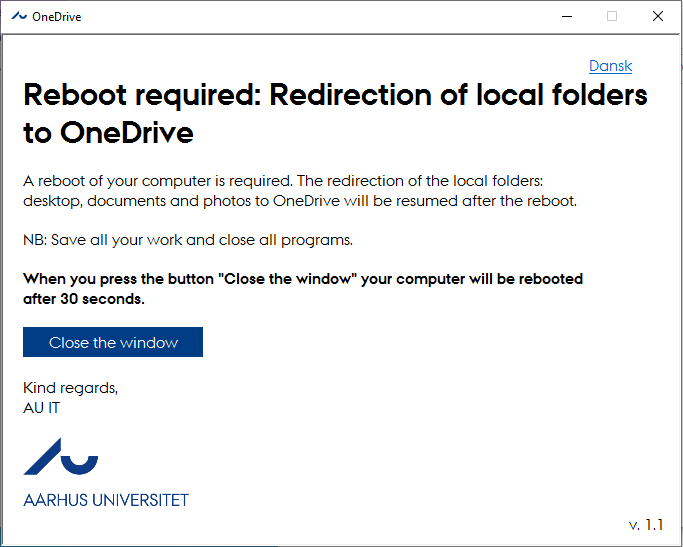
-
Once you have logged in to OneDrive, just follow steps 1 to 4.
Important information
- You will only have read access to the U drive when the file-migration process starts. Once the files have been moved to OneDrive, you will no longer be able to access them on the U drive. If you need to edit a file on the U drive during the move, you can save the file on OneDrive and work on it there. The move can take one to seven days, depending on the number and size of the files.
- When your files have been moved to OneDrive, you will no longer have access to the U drive.
- You will not receive a notification on your computer when the files have been transferred.
- You will still be able to access your files on your desktop and the 'Documents' and 'Pictures' folders.
For users with a special setup on their PC
If you have received an email stating that you have a special setup on your AU computer that requires you to be physically present at AU while your files are being transferred, please follow the instructions below. Check when AU IT are going to start moving your files from the U drive to OneDrive in the email you received about the transition to OneDrive.
Please note that unfortunately you cannot use your computer while your files are being transferred to OneDrive. It is difficult to say exactly how much time the migration will take, but for approx. 80% of employees it will take approx. 10 minutes. However, if you have large amounts of data, it may take up to several hours.
How to initiate migration of your files to OneDrive
You have to initiate the migration yourself of your files from your desktop and the 'Documents' and 'Pictures' folders to Onedrive. After the migration, you will still be able to access the files on your desktop and in the 'Documents' and 'Pictures' folders.
Follow steps 1-6 if you have activated OneDrive
Follow step 7 if you have not activated OneDrive
1. 
2. If you cannot initiate the relocation of your files, you will receive the following pop-up message. If you receive this message, you can get help from your local IT support team.
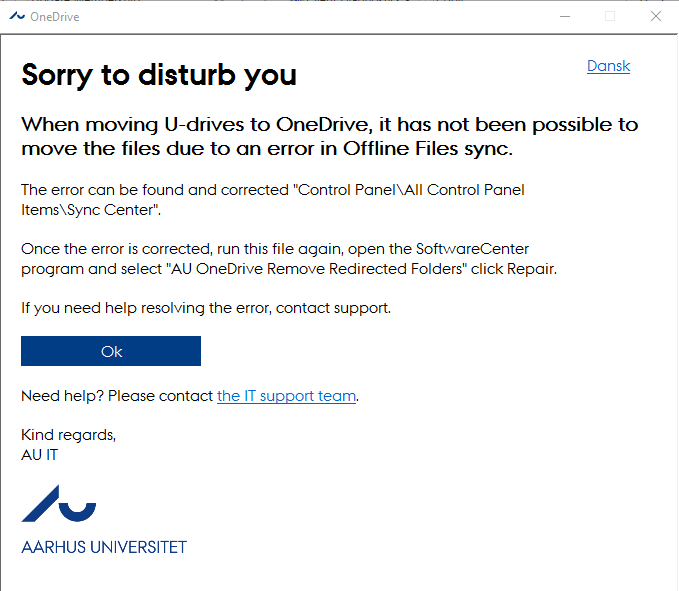
3. If you can initiate the migration, you should simply follow the instructions in the pop-up message and the subsequent messages.
If you have not been logged in to OneDrive before, follow steps 7 to 9.

4.

5.

6. At the last box, it is important, that you check that you have selected ALL your folders before you proceed with the configuration. When you click on the Close the window button, the migration will begin.

7. If you have not been logged in to OneDrive before the day of the migration of your files, you will receive this pop-up message:

8.

9. Once you have logged in, you will see a brief intro to OneDrive. Your computer may require restarting in connection with log in. If this happens, you will receive the following pop-up message.

- Once you have logged in to OneDrive, just follow steps 3 to 6.
Important information
- You will only have read access to the U drive when the file-migration process starts. Once the files have been moved to OneDrive, you will no longer be able to access them on the U drive. If you need to edit a file on the U drive during the move, you can save the file on OneDrive and work on it there. The move can take one to seven days, depending on the number and size of the files.
- When your files have been moved to OneDrive, you will no longer have access to the U drive.
- You will not receive a notification on your computer when the files have been transferred.
- You will still be able to access your files on your desktop and the 'Documents' and 'Pictures' folders.
Folders and files on OneDrive
On OneDrive, you will be able to see the following folders after your files have been transferred:
- U drive: Contains data from your U drive.
- If you have not had data on the U drive, it will not be shown.
- It may take one to seven days before your data has been moved to OneDrive. The folder will not be shown until the move has been initiated.
- Desktop: Contains your desk top
- Documents: Contains files from the Dokumenter (Documents) folder.
- Images: Contains files from the Billede (Images) folder.
- Profile-data: Contains technical information about your Windows computer.
NOTE! You should not to use this folder for your personal data.
You can create new folders yourself on OneDrive for your files.